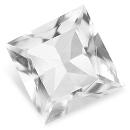|
|
|
|
Click on a letter above to view the list of gems. |
|
|
|
|
|
Petalite |
|
| Chemistry: LiAlSi4O10 [] | |
| Discovered
in 1800;
IMA
status: Valid (pre-IMA; Grandfathered). | ||
|
| ||
|
Classification |
|
|
| |
|
Silicates | |
|
8/J.03-10 | |
|
|
9 : SILICATES (Germanates) |
|
Related to: |
Petalite - Virgilite Series |
|
|
|
|
Crystal Data |
|
|
|
|
|
Crystals tabular on [010], or elongated, to 2 m; some faces may be striated. Commonly foliated cleavable, massive. |
|
|
Common on [001], lamellar |
|
|
|
|
|
Physical Properties |
|
|
|
|
|
[001] Perfect, [201] Imperfect |
|
|
Imperfectly Conchoidal |
|
|
Brittle |
|
|
6.0 - 6.5 |
|
|
2.412 - 2.422 (g/cm3) |
|
|
Thermoluminescent |
|
|
Not Radioactive |
|
|
|
|
|
Optical Properties |
|
|
|
|
|
Colorless, White, Gray, Yellow, Pink |
|
|
Translucent to Transparent |
|
|
Vitreous, Pearly on cleavages |
|
|
1.504 - 1.523 Biaxial ( + ) |
|
|
0.0120 - 0.0140 |
|
|
Weak; r > v |
|
|
None |
|
|
|
|
|
Occurances |
|
|
|
|
|
Geological Setting: |
In granite pegmatites, locally constituting an ore of lithium. |
|
Common Associations: |
Albite, Spodumene, Lepidolite, Microcline, Pollucite, Quartz, Topaz, Tourmaline |
|
Common Impurities: |
Mg,Fe,Na,Ca,K,H2O |
|
Type Locality: |
Utö Island, Haninge, Södermanland, Sweden |
|
Year Discovered: |
1800 |
|
View mineral photos: | |
|
|
|
|
More Information |
|
|
|
|
|
| |
|
|
|
|
The name Petalite is from the Greek petalos meaning leaf in regard to its perfect basal cleavage. The name for the crystals that Petalite is cut from is Castorite, named after Castor. Castor and Pollux were heavenly twins and brothers of Helen of Troy from Greek mythology. Pollux is the basis for the naming of Pollucite. The
main sources of gem quality crystals are Paprok, Nuristan Province,
Afghanistan; Bahia,
Northeast Region, Brazil; Minas Gerais, Southeast Region, Brazil; and Mogok, Sagaing District, Mandalay Division, Burma
(Myanmar). |
|
|
We
have not photographed our Petalite gems yet. Please
check back soon! |
